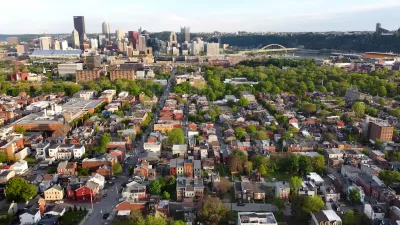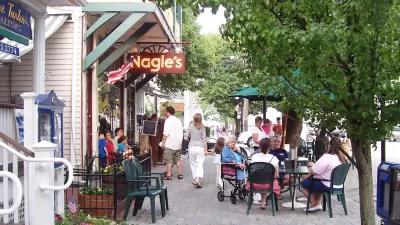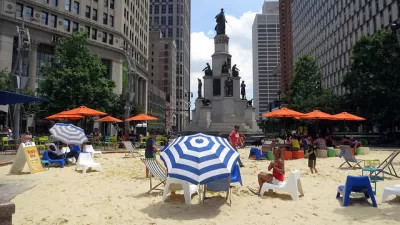The conference bags handed out to the attendees of the 2007 National Planning conference in Philadelphia had four words printed on one side: value, choice, engagement, community. The words echo the long mission statement of the American Planning Association, evidence of what I described last year as the pragmatic position of the profession that refrains from making a larger argument about the form of the city. Here's a taste: "Our collaborative efforts will continue to result in great success for APA and the vital communities we strive to support, and APA members will continue to help create communities of lasting value. We value choice and community engagement, diversity, inclusion and social equity."Since then, a new program from the organization and other evidence may suggest a subtle shift in professional values now underway.
The conference bags handed out to the attendees of the 2007 National Planning conference in Philadelphia had four words printed on one side: value, choice, engagement, community. The words echo the long mission statement of the American Planning Association, evidence of what I described last year as the pragmatic position of the profession that refrains from making a larger argument about the form of the city. Here's a taste:
"Our collaborative efforts will continue to result in great success for APA and the vital communities we strive to support, and APA members will continue to help create communities of lasting value. We value choice and community engagement, diversity, inclusion and social equity."
Since then, a new program from the organization and other evidence may suggest a subtle shift in professional values now underway.
The "Great Places in America" program is an awards program for "great" streets, neighborhoods, and public spaces in America with the goal to celebrate "places of exemplary character, quality, and planning" and "represent the gold standard in terms of having a true sense of place, cultural and historical interest, community involvement, and a vision for tomorrow."
For a profession long maligned for a lack of clear identify or vision, the group of winners from 2007 and 2008 form a remarkably coherent group. Including such iconic places as Philadelphia's Society Hill and Washington, D.C.'s union station, but also more obscure sites like Cleveland's West Side Market and downtown Sheridan, Wyoming. In general the winning neighborhoods, streets, and public spaces are resoundingly urban and historic. None of the winners are strip malls, 1970s planned unit developments, or conventional suburban residential neighborhoods.
The program has sparked remarkably little controversy (that I'm aware of). The local media in winning cities have dutifully covered the story, providing a rare opportunity for a positive story. Few inside the profession or the general public, have raised doubts that the winners were "great" places.
From a larger perspective, the implied argument from the winners is something akin to the argument put forth in Mark Hinshaw's True Urbanism: a vigorous argument for high density, mixed-use urbanism of the type celebrated by Jane Jacobs. I'll leave it to someone else to closely evaluate the criteria and winners in a more systematic way, but the program makes it clear these are places the APA believes people want to "live and work everyday." Meanwhile, outside the world of the professional association, a shift has taken place.
Although they carry a small percentage of total travelers, diverse cities across the country are making major new investments in public transit systems. The president talks straight-faced about developing high speed rail. Even the lowly inter-city bus may have stabilized and begun a cautious comeback. Present shocks aside, the housing market is displaying unexpected patterns with an "inward momentum" revitalizing center cities. Green building and mixed-use development are becoming the norm. Sophisticated planning efforts, including complete streets programs, historic preservation, and innovative forms of zoning are flourishing in most cities. To be sure, these trends have many causes: energy costs, changing demographics, even global warming. However the factor of changing culture or values cannot be eliminated.
In an article last year I described why I thought New Urbanism has been such a misunderstood and controversial movement. One of the responses on a private listserv criticized the article for not offering any solutions or alternatives, something I found troubling. However, I think the solution has been right here under our noses all along. Many of the values of New Urbanism are becoming the profession's mainstream values.
We are entering a new era of normative urban planning in America.

Alabama: Trump Terminates Settlements for Black Communities Harmed By Raw Sewage
Trump deemed the landmark civil rights agreement “illegal DEI and environmental justice policy.”

Planetizen Federal Action Tracker
A weekly monitor of how Trump’s orders and actions are impacting planners and planning in America.

The 120 Year Old Tiny Home Villages That Sheltered San Francisco’s Earthquake Refugees
More than a century ago, San Francisco mobilized to house thousands of residents displaced by the 1906 earthquake. Could their strategy offer a model for the present?

Ken Jennings Launches Transit Web Series
The Jeopardy champ wants you to ride public transit.

BLM To Rescind Public Lands Rule
The change will downgrade conservation, once again putting federal land at risk for mining and other extractive uses.

Indy Neighborhood Group Builds Temporary Multi-Use Path
Community members, aided in part by funding from the city, repurposed a vehicle lane to create a protected bike and pedestrian path for the summer season.
Urban Design for Planners 1: Software Tools
This six-course series explores essential urban design concepts using open source software and equips planners with the tools they need to participate fully in the urban design process.
Planning for Universal Design
Learn the tools for implementing Universal Design in planning regulations.
Clanton & Associates, Inc.
Jessamine County Fiscal Court
Institute for Housing and Urban Development Studies (IHS)
City of Grandview
Harvard GSD Executive Education
Toledo-Lucas County Plan Commissions
Salt Lake City
NYU Wagner Graduate School of Public Service






























